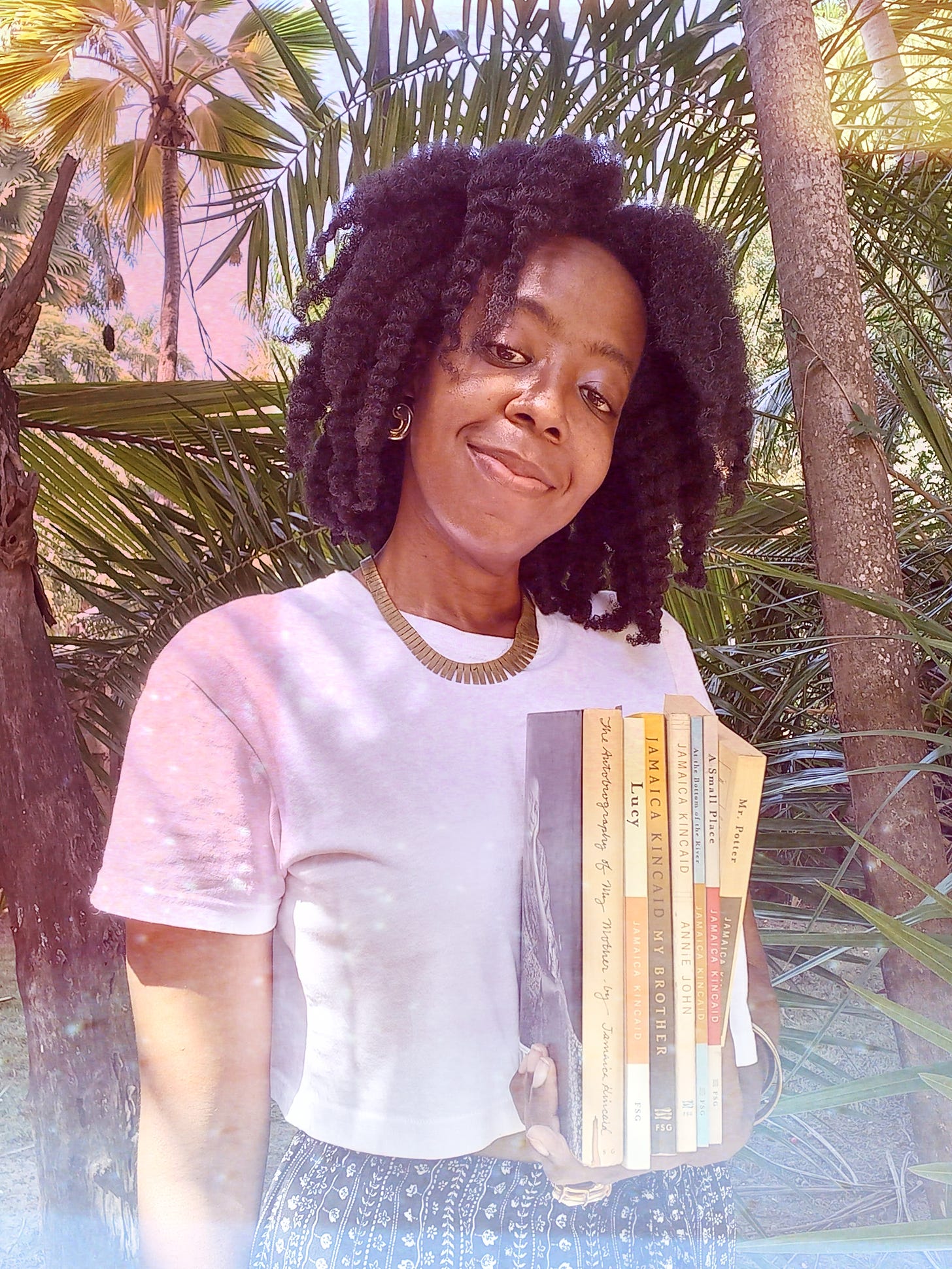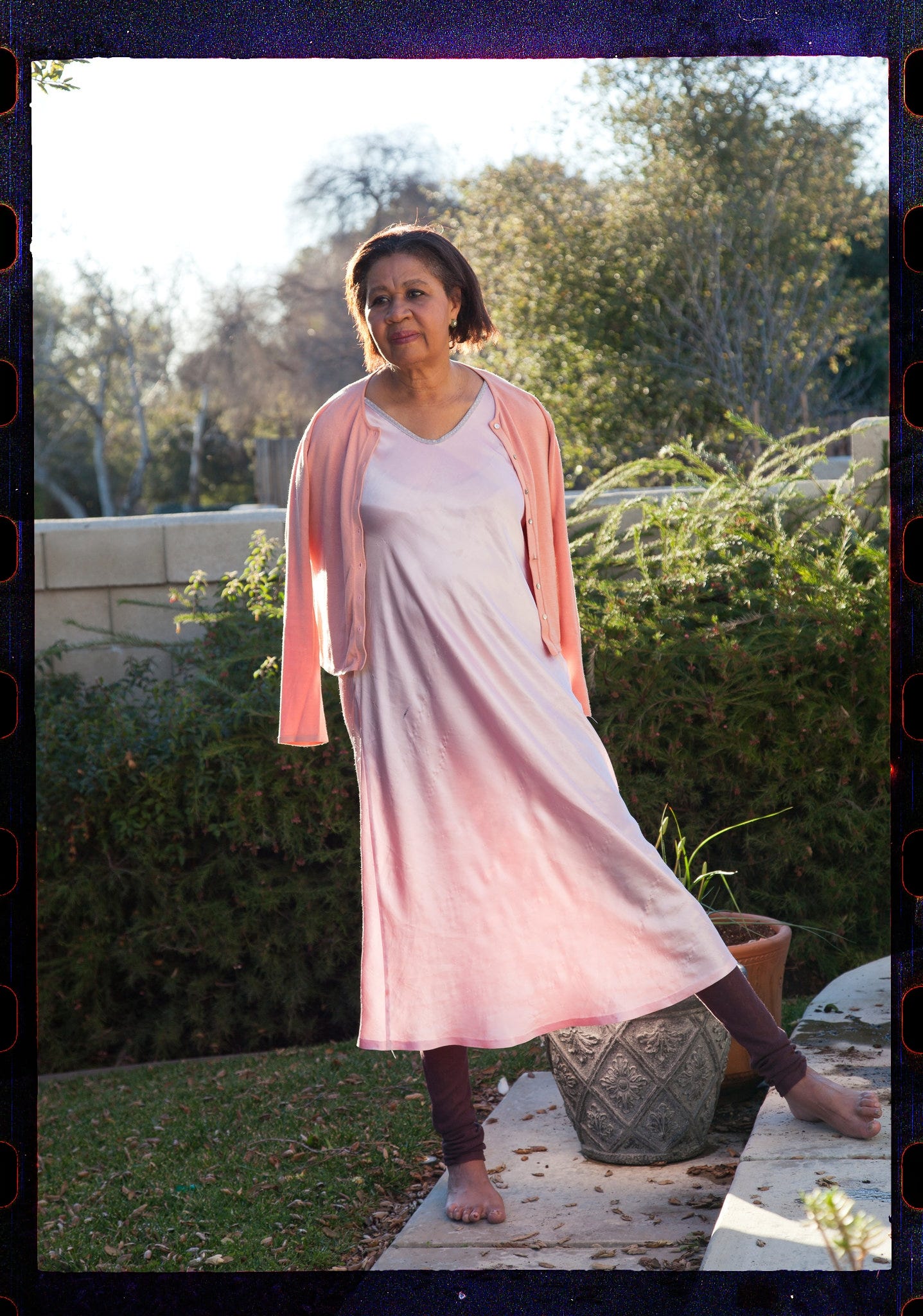The Curator
My name is Akilah aka Kiki. Most of you may know me through my bookstgram persona on Instagram at ifthisisparadise. Depending on where else you encounter me online my bio may detail that I’m a critic or a freelance media writer or a reviewer—the unprofessional expression of my inner anxiety of who/what I am when I write in longer form about literature. I’m surer about being a beta reader and a devout paying pastry nyammer who languishes in and by various water bodies whenever I can.
Why #WeReadJamaicaKincaid?
In my bookstagram network others associate me with particular authors because of my passion for their work: Maryse Condé, Olive Senior, Sofia Samatar. Sometimes I come to that passion easily, a literary insta love the intensity of which increases over time. Sometimes the insta love starts in the “It’s Complicated” zone and never leaves. Other times an unassuming first encounter, after many years of wandering, mushrooms unpredictably on second contact.
Are you attached to a book as a physical object? You may have an ideal concept of what it looks like drawn from memories, from your flushed, steady devotion. As I read my copy of Annie John by Jamaica Kincaid I thought, ‘This is mine.’
You may read my personal essay on Badform Review about that later second encounter with Kincaid after many years. The briefer story is that a re-read of Annie John more than a decade after the first proved how much of literature’s power was beyond my control. It could spore, catch, and grow in me, bear fruit, fall, rot and repeat the cycle for years and years without me knowing, until the day “by chance” I chose to see it, pick it as if it had grown in a different yard, only to taste to fruit and come to know myself.
Kincaid laid hands on that power, then. I had to find a way to reckon with it too, work it (work it out of me?) somehow. Hence this project.
I am not a Kincaid expert. I have read none but two of her titles: A Small Place many years ago and Annie John for the second time earlier this year. I invite you as a fellow companion in this reading venture.
The Writer
Jamaica Kincaid was born as Elaine Cynthia Potter Richardson in Antigua and Barbuda on May 25, 1949 “into poverty” according to her bio on the Carnegie “Great Immigrant Awards” website. Her family sent her to New York, in the United States, in order to work as an au pair, a nanny, or as Kincaid herself sometimes named it, “a servant”, shortly after her 16th birthday. She took night classes, became a writer at the New Yorker, and from there her writing career launched. Once you’ve taken in a lot of her interviews the oft repeated details may begin to waver in importance or accrue a certain meaninglessness.
What remained fascinating to me at this early stage was her public persona for in-person interviews. She and various media entities have created a rich video, audio and text interview archive, many of which are available online. It’s always interesting to compare how we perceive a writer in the flesh to our initial impressions of them formed on the page. Her voice sounded a bit more…tenatiave than I expected? There was a perpetual questioning lilt…or perhaps it’s more of a curious self-effacing tone that worked in great contrast to her satisfaction in commanding all of the attention in a room. She fidgeted a lot. Her hands were in constant movement—she played with a sleeve or hem as she spoke, sometimes glancing down and around.
Here was a biographical detail that didn’t feel worn out. She studied photography during night school at the New York School for Social Research after she left domestic work. I had not known this before I started to prep for this project. I immediately thought of An Autobiography of the Autobiography of Reading by Dionne Brand. She opened with a long rumination on a childhood photograph: on the process’ attempted disciplining effect and how the children disrupted it, the histories that informed the photograph’s creation in the first place, its intended audience (her mother and aunt recently migrated to England, but also England itself) and much more.
I began to think about the “pictures” of Kincaid I had already formed in my mind with her writing, with the interviews both in text, audio and video, and all the different figures who played a role in creating it, framing it, changing it. I recently came across a quote from Homi K. Bhaba’s The Location of Culture in Myriam J. A. Chancy’s Autochthonomies: Transnationalism, Testimony, and Transmission in the African Diaspora.
From this point of view, discusive ‘transparency’ is best read in the photographic sense in which a transparency is also always a negative, processed into visibility through the technologies of reversal, enlargement, lighting, editing, projection, not a source but a re-source of light.
What will emerge for you, for me not just from text but sound, from memories and histories, and all that we will experience over the next 20 months? Not a source but a re-sourcing of light.
These are my rambling after midnight thoughts as I push through to get this newsletter to you before I’m lost to holidaying.
Paraphernalia
The Interviews
Here is a fertile quote from an interview by Moira Ferguson, published in the Winter 1994 issue of The Kenyon Review under the title “A lot of Memory: An Interview with Jamaica Kincaid”. Moira Ferguson (b. 1938) was a Professor of English at New York University and wrote two relevant Kincaid texts: Colonialism and Gender Relations from Mary Wollstonecraft and Jamaica Kincaid: East Caribbean Connections (1993) and Jamaica Kincaid: Where the Land Meets the Body (1994).
MF: Do you remember the first time you wrote? What was your inspiration and starting point?
JK: I was in college and thought I would be a photographer, and I used to write out my photographs. If there was an inspiration, if there was a moment when I thought, "Oh, something could be done; somehow my thoughts could be written down," it must have been the moment I saw a French film called La Jete, and I was reading Alain Robbe-Grillet. That was a big inspiration. And I began to write poems. I began to write of my photographs-what I would take and [how] I would set them up. I would look at what I had written down, and that is how I would take the photograph. I would write down what I thought the picture should feel like. And I would try to take a picture of what I had written down.
For more on how photography has influenced her work watch her recent interview with Jackie Kay at the 2022 Edinburgh Literary Festival. Jackie Kay (b. 1961) is a Scottish poet, playwright and novelist who is Professor of Creative Writing at Newcastle University. The photography talk starts at around 24:19 but the entire conversation is worth a watch. Unfortunately, I could not find a transcript but the video has an automated caption.
Jamaica Kincaid: Write Out of Defiance
Peers without Realms
Dionne Brand (b. 1953) is a poet, novelist, filmmaker and newly appointed editorial director of Alchemy, a new Knopf Canada imprint. She was born in Trinidad and Tobago and migrated to Canada at around the same age as Kincaid. An expanded version of An Autobiography of the Autobiography of Reading was published but its original form was given as part of the CLC Kreisel Lecture Series, freely available on YouTube.
My review of An Autobiography of the Autobiography of Reading at The Book Slut
The 2019 CLC Kreisel Lecture with Dionne Brand
Art End Notes
Naturally, I recommend watching La Jetée (1962) a “French science fiction featurette directed by Chris Marker and associated with the Left Bank artistic movement. Constructed almost entirely from still photos, it tells the story of a post-nuclear war experiment in time travel. It is 28 minutes long and shot in black and white.” (Wikipedia) I watched it for free on YouTube.
At the Close
This newsletter could have been twice as long if I really dug into what I touched on here. Worry not friends for we have a Discord! Here is the invite link: https://discord.gg/qzdtzWyw. (If you read this newsletter after the link expires feel free to contact me for a new one. My contact info is at the end.) Come settle in, explore, share your thoughts on the newsletter and get ready for January 2023 (next week :o) when we start with the first book At the Bottom of the River (1983). Expect the next newsletter issue then.





